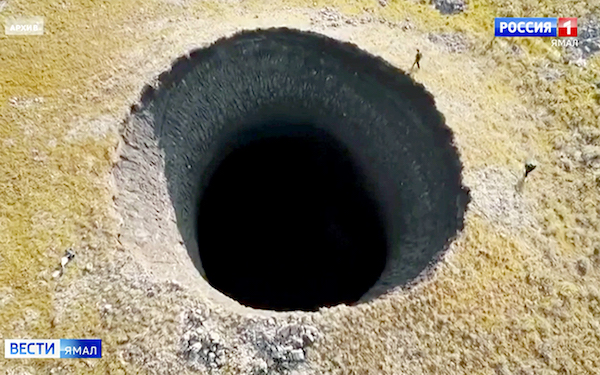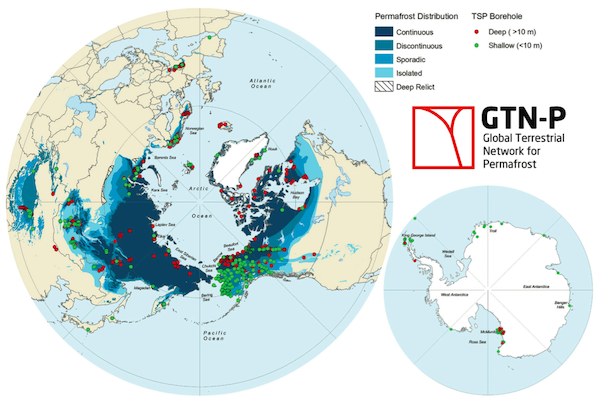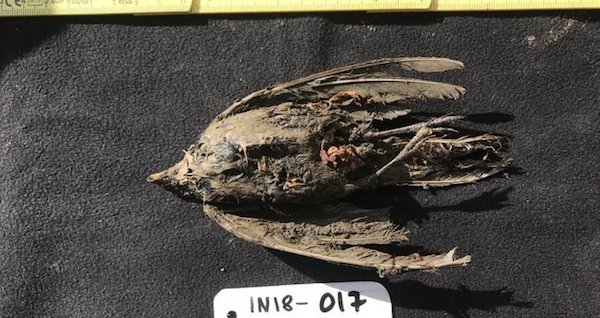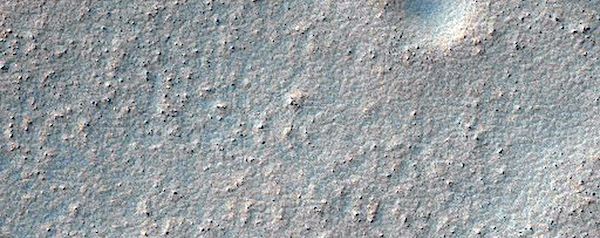
By Lambert Strether of Corrente.
In my slow perambulation through the biosphere, I have finally arrived at the cryosphere, which I didn’t even know was a word. Here is what it means:
There are places on Earth that are so cold that water is frozen solid. These areas of snow or ice, which are subject to temperatures below 32°F for at least part of the year, compose the cryosphere. The term “cryosphere” comes from the Greek word, “krios,” which means cold.
Ice and snow on land are one part of the cryosphere. This includes the largest parts of the cryosphere, the continental ice sheets found in Greenland and Antarctica, as well as ice caps, glaciers, and areas of snow and permafrost.
I considered Himalayan glaciers tangentially when writing about the Mekong here, but today I’m going to focus on permafrost, my interest having been piqued by this enormous crater, which suddenly appeared in Siberia:

(The caption: “Blocks of soil and ice thrown hundreds of metres from epicentre of the funnel at the Yamal peninsula.”) The Siberian Times describes the crater:
Scientist Dr Evgeny Chuvilin, a leading researcher at Skolkovo Institute of Science and Technology, said: ‘What we saw today is striking in its size and grandeur.
‘These are the colossal forces of nature that create such objects.’
The ‘crater’ – these holes are called hydrolaccoliths or bulgunnyakhs by scientists – is given the number 17, and is seen as the most impressive of the large holes to suddenly appear in recent years as the permafrost thaws. The recently-formed new hole or funnel is the latest to be seen in northern Siberia since the phenomenon was first registered in 2014.
It was initially spotted by chance from the air by a Vesti Yamal TV crew en route from an unrelated assignment.
A group of scientists then made an expedition to examine the large cylindrical crater which has a depth of up to 50 metres.
Such funnels are believed to be caused by the build up of methane gas in pockets of thawing permafrost under the surface.
I remember, from grade school, going to the school auditorium to see a slideshow — the projection technology then used — on permafrost, given by a scientist from the university. I was fascinated to see buildings whose foundations were set in permanently frozen ground, but it seems that permafrost was not so permanent after all! Here is a definition of permafrost from Global Crysophere Watch:
Permafrost, defined as sub-surface earth materials that remain at or below 0˚C continuously for two or more years, is widespread in the Arctic, sub-Arctic, and high-mountain regions, and in ice-free areas of the Antarctic and sub-Antarctic. An area can have continuous, discontinuous, sporadic, or isolated permafrost, but the only metric used to truly identify an area of permafrost is temperature.
They go on to explain:
Permafrost and its processes have a significant impact on the land it covers. In turn, the land covered by permafrost has a significant impact on the thickness and extent of permafrost. For example, in areas of the Arctic with permafrost and active layers, peat plays a vital role in the transfer of heat to and from the ground.
(I will disappoint the many soil fans in the readership, but I am going to blow past peat today.) The active layer — an example of permafrost zonation, another word I didn’t know existed — will become important shortly. It is:
A layer of soil on top of permafrost does not stay frozen all year. This layer, called the active layer, thaws during the warm summer months and freezes again in the fall. In colder regions, the ground rarely thaws—even in the summer. There, the active layer is very thin—only 4 to 6 inches (10 to 15 centimeters). In warmer permafrost regions, the active layer can be several meters thick.
Here is a map of the areas of the globe covered by permafrost from the International Permafrost Association[1]:

(Other maps are here and here. I prefer this one because it includes the green and red dots for boreholes, which show that permafrost in Alaska is mostly shallow, but permafrost in Canada and Russia is mostly deep.)
The methodology used to develop such maps is important. From Science Direct, “Northern Hemisphere permafrost map based on TTOP modelling for 2000–2016 at 1 km2 scale:
Terrestrial permafrost monitoring is coordinated within the Global Terrestrial Network for Permafrost (GTN-P; Biskaborn et al., 2015), where ground temperatures are measured in >1000 boreholes, but only at discrete points. Extrapolating these observations to larger regions is hampered by the considerable spatial variability of the ground thermal regime and an uneven distribution of sites that results in extensive unsampled areas (Biskaborn et al., 2015, Biskaborn et al., 2019).
Despite its global significance, there is still no method to reliably detect the occurrence and extent of permafrost at medium to high spatial resolutions and at a global scale. While the occurrence of permafrost cannot be directly detected using remote sensing, satellite data can be used in characterizing permafrost extent and detecting changes indirectly using two different approaches (Westermann et al., 2015c): (1) remote identification and mapping of surface landforms that indicate the existence of permafrost, and (2) remote sensing of physical variables that relate to thermal subsurface conditions.
So, in essence, the map’s conformity to the territory it represents is only as good as the model used, the sensors available, and proxies like landforms[2]. One particular landform, thermokarst, shows where permafrost has thawed, and hence rules out some areas from the map:
Thermokarst lakes form as a result of permafrost thaw in predominantly ice-rich yedoma [organic rich] deposits and are therefore an ecosystem that is rapidly expanding with the onset of climate change.
The difficulty — exemplified by Hydrolaccolith #17 on the Yamal peninsula — is that permafrost is thawing more rapidly than previously thought. From Geophysical Research Letters, “Climate Change Drives Widespread and Rapid Thermokarst Development in Very Cold Permafrost in the Canadian High Arctic“:
Permafrost in Arctic lowland regions is frequently characterized by large volumes of ground ice which, when it melts, causes the ground surface to collapse. As the Arctic warms, ice‐rich permafrost degradation is expected to be widespread. Our data illustrate that very cold permafrost, which has a mean annual ground temperature of −10 °C or lower, is experiencing a rapid increase in active layer thickness at annual time scales. At three permafrost monitoring sites in the Canadian Arctic we have observed that warmer than average summer air temperatures have caused the active layer to deepen, near‐surface ground ice to melt, and the overlying ground surface to subside, in some cases leading to the formation of small thaw ponds. Our results show that very cold permafrost terrain is responding rapidly to ongoing warming.
(Arctic wildfires are also a cause, besides global warming as such.) The scientists described their experience to the Guardian, in “Scientists shocked by Arctic permafrost thawing 70 years sooner than predicted“:
The team used a modified propeller plane to visit exceptionally remote sites, including an abandoned cold war-era radar base more than 300km from the nearest human settlement.
Diving through a lucky break in the clouds, Romanovsky and his colleagues said they were confronted with a landscape that was unrecognisable from the pristine Arctic terrain they had encountered during initial visits a decade or so earlier.
The vista had dissolved into an undulating sea of hummocks – waist-high depressions and ponds known as thermokarst. Vegetation, once sparse, had begun to flourish in the shelter provided from the constant wind.
Yikes! So what happens when permafrost thaws? Besides micro-organisms eating the nearly thawed organic matter, emitting methane and, at scale, causing craters to explode into being? Basically, things appear out of the ice. Birds, for example. (This is a specied of horned lark.)

Or puppies. From Science Alert, “Puppy Preserved in Permafrost Ate a Chunk of One of Earth’s Last Woolly Rhinos“:
Researchers made this discovery while doing a necropsy (an animal autopsy) on the mummified remains of the ice age puppy. After finding an undigested slab of skin with yellow fur in the puppy’s stomach, researchers initially thought the puppy had chewed off a hunk of cave lion meat for its last meal.
But a DNA analysis of the slab revealed that it wasn’t a cave lion (Panthera spelaea), but a woolly rhinoceros (Coelodonta antiquitatis), which went extinct around 14,000 years ago, right about the time that this pup had its last meal.
That means this puppy ate one of the last woolly rhinos to ever exist
However, other, more consequential things may happen. Ancient diseases may re-appear. The built environment becomes unstable. And, most importantly, carbon (CO2 and methane), previously fixed in ice, is released into the atmosphere. Let us briefly consider each of these effects in turn.
Ancient Diseases
The BBC has the following, rather histrionic headline: “There are diseases hidden in ice, and they are waking up“:
Frozen permafrost soil is the perfect place for bacteria to remain alive for very long periods of time, perhaps as long as a million years. That means melting ice could potentially open a Pandora’s box of diseases.
“Permafrost is a very good preserver of microbes and viruses, because it is cold, there is no oxygen, and it is dark,” says evolutionary biologist Jean-Michel Claverie at Aix-Marseille University in France. “Pathogenic viruses that can infect humans or animals might be preserved in old permafrost layers, including some that have caused global epidemics in the past.”
However, it seems we can rule out viruses, at least provisionally. From the New Republic, another histrionic headline: “The Next Pandemic Could Be Hiding in the Arctic Permafrost.” Nevertheless:
So far, few of the viruses recovered from the permafrost seem to be active or contagious. In the bodies from the 1890s smallpox outbreak, for example, researchers were able to find some viral material to confirm that the people had indeed died of the virus, but they did not find completely intact viruses that would have been contagious. Attempts to cultivate other permafrost viruses in laboratories have largely failed.
Some hardy bacteria, on the other hand, seem to be just as potent as when they were buried. Not all bacteria can survive the harsh conditions of the Arctic for long periods of time, but a few—like anthrax, tetanus, and the bacteria that causes botulism—can.
So that’s good news!
The Built Environment
Much of Russia’s Siberian territory is built on the assumption that permafrost is permanent. From Young Pioneers Tours, “The Road of Bones: the Kolyma Highway“:
[T]his enormous road through the Russian Far East stretches an incredible 2,031 km (1,262 mi). Whilst work began in 1932; the road took over twenty years to complete and was built almost entirely through the forced labour of local gulags. The work was inherently gruelling and was undertaken in all weathers, from the bitter Siberian winter where temperatures would drop to Minus 50 degrees to the unforgiving, mosquito-infested summers. As a result, at least 25 prisoners died every day. Due to the road being built on permafrost, it was much more practical to bury the corpses in the fabric of the road than to keep digging graves. To this day, many report the bones of the dead workers rising to the surface of the road….
So, not just birds and puppies (or mammoths, whose appearing tusks are fueling an international black market). And then there is an entire city of 300,000: Yakutsk. From the Washington Post, “Radical warming in Siberia leaves millions on unstable ground“:
As the permafrost thaws and recedes, a handful of apartment buildings there are showing signs of structural problems. Sections of many older, wooden buildings already sag toward the ground — rendered uninhabitable by the unevenly thawing earth. New apartment blocks are being built on massive pylons extending ever deeper — more than 40 feet — below ground.
“The cold is our protection,” Yakutsk Mayor Sardana Avksentyeva said. “This isn’t a man-made catastrophe yet, but it’ll be unavoidable if things continue at this pace.”
An international team of scientists, led by Dmitry A. Streletskiy at George Washington University, estimated in a study published this year that the value of buildings and infrastructure on Russian permafrost amounts to $300 billion — about 7.5 percent of the nation’s total annual economic output. They estimate the cost of mitigating the damage wrought by thawing permafrost will probably total more than $100 billion by 2050.
(This article also gives a vivid sensory portrait of what its like to live on, in, and around thawing permafrost.)
Finally, there is the effect on Russia’s oil drilling infrastructure. From Emerging Europe, “Melting permafrost is a threat not just to the Arctic, but to the entire planet“:
“Thawing permafrost has both regional and global impacts. For northern countries, the risks are from ground collapse that occurs when ice rich permafrost thaws. This ground collapse can be quite severe, but even in less extreme situations, can place houses, community infrastructure, and gas and oil infrastructure at risk,” [Dr Sue Natali from the Woodwell Climate Research Centre] explains.
This kind of impact has already been witnessed across northern countries, where melting permafrost means the ground is no longer able to support structures built on it. For many, this raises particular concerns over the oil and gas industry, which is the primary economic sector in the Arctic Circle.
Pipelines, processing plants and storage tanks on unstable and thawing ground become a serious threat to the natural environment. In some cases, accidents have already taken place.
The Intergovernmental Panel on Climate Change (IPCC) released a report last September that found 45 per cent of oil and natural gas production fields in the Russian Arctic are located in the most hazardous and at-risk region. Moreover, areas of discontinuous permafrost could see a 50-75 per cent drop in load bearing capacity over the period from 2015-25 in comparison to 1975-85.
Carbon Release
Finally, there is carbon. From NASA, “Arctic carbon cycle is speeding up”
During Arctic summer, warmer temperatures thaw the uppermost [“active”] layers of permafrost, allowing microbes to break down previously frozen organic matter.This process releases carbon dioxide into the atmosphere. Plant growth also increases during this period – and plants remove carbon dioxide from the atmosphere through photosynthesis. But as temperatures increase, the amount of time carbon is stored in the Arctic soil decreases.
“The balance between these two dynamics will determine whether Arctic ecosystems will ultimately remove or add atmospheric carbon dioxide in the future climate. Our study finds that the latter is more likely,” said lead author and former JPL postdoctoral researcher Sujong Jeong of Seoul National University. “We anticipate that residence time of Arctic carbon will lead to faster and more pronounced seasonal and long-term changes in global atmospheric carbon dioxide.”
And there’s rather a lot of carbon. From Global Cryosphere Watch:
Recent studies have begun to address the tons of carbon dioxide, methane, and other greenhouse gasses that are buried within permafrost. The current estimate on the amount of carbon stored in permafrost is around 1,400 gigatons—almost twice what is currently in the earth’s atmosphere (K. Schaefer, NSIDC). Yedoma, a type of permafrost that has existed since the Pleistocene period and is found mostly around Russia and Siberia, contains huge amounts of carbon that could be released into the atmosphere if it were to thaw.
Unfortunately, our current climate models do not incorporate carbon release from thawing permafrost. From Nature, “Carbon release through abrupt permafrost thaw“:
The permafrost zone is expected to be a substantial carbon source to the atmosphere, yet large-scale models currently only simulate gradual changes in seasonally thawed soil. Abrupt thaw will probably occur in
Confirmation from Emerging Europe:
“Internationally, the major challenge is from the potential for carbon emissions from permafrost once it thaws,” continues Dr Natali. “The permafrost region stores more than three times as much carbon as the world’s forest biomass, and when it thaws, that organic carbon can be decomposed by microbes and released into the atmosphere as greenhouse gasses, carbon dioxide and methane. This additional source of greenhouse gasses is generally not fully accounted for.”
Now, “abrupt thaw” might not be a complete disaster[3], incomplete models or no[4]. From National Geographic, “The Arctic’s thawing ground is releasing a shocking amount of dangerous gases“:
[“Abrupt thaw”] will probably hit just 5 percent of Arctic permafrost. But that will likely be enough, conservatively, to double permafrost’s overall contribution to the warming of the planet, the team of researchers led by Turetsky concluded in a study published Monday in the journal Nature Geoscience.
“It’s a little change, but it can have a big punch,” says Turetsky, director of the Institute for Arctic and Alpine Research at the University of Colorado.
Abrupt thaw is not a cause for alarm, the scientists say. Permafrost will still produce fewer emissions than our own burning of coal, oil and natural gas. David Lawrence, a senior scientist at the National Center for Atmospheric Research in Boulder, Colorado, said that—until now— thawing permafrost had been expected to amplify human-caused climate change by about 10 percent.
But doubling that figure is significant because the Intergovernmental Panel on Climate Change—the global organization that estimates how quickly we need to stop burning fossil fuels to keep the worst warming at bay—has not taken permafrost fully into account.
The World Economic Forum summarizes, in “The irreversible emissions of a permafrost ‘tipping point‘”
Arctic temperatures have been increasing more than twice as fast as the global average. This has caused permafrost thaw in many locations and triggered newly awakened microbes to decompose the organic material thereby releasing CO2 or methane into the atmosphere….
Scientists estimate that there is about twice as much carbon stored in permafrost as circulating in the atmosphere. This is approximately 1460bn-1600bn tonnes of carbon.
Most of it is currently frozen and preserved, but if even a small fraction is released into the atmosphere, the emissions would likely be large – potentially similar in magnitude to carbon release from other environmental fluxes, such as deforestation.
This would still be about one order of magnitude smaller than emissions from fossil-fuel burning by the end of this century. Nevertheless, every additional molecule of CO2 or methane added to the atmosphere accelerates climate change and affects the whole planet and its climate.
Conclusion
So, what to do? It’s hard to imagine that there are enough people on the thawing ground for their mobilization to have an effect. Therefore, solve global warming in other systems, and the active layer stops melting. Once again, the World Economic Forum:
Once the organic matter within permafrost decomposes and releases CO2 and methane, there is no getting it back. In this sense, permafrost thaw is irreversible – meeting one of the conditions of the definition of a tipping point.
However, recent research suggests that if temperature rise were to slow and stop, permafrost thaw, too, would slow – and potentially stop, thus, preventing further emissions.
This suggests that permafrost as a whole will not have shifted to a completely new state – as is the case with some tipping points, such as the melting of the Greenland ice sheet. As a result, it would be possible to prevent further emissions were global warming to be halted.
However, there may also be a solution that would work, if applied on the thawing ground itself. From Horse Talk (!), “Could horses be the saviour of swathes of permafrost? Researchers investigate“:
Theoretically, 80 percent of all permafrost soils around the globe could be preserved until the year 2100, as has now been demonstrated by Professor Christian Beer from the university’s Center for Earth System Research and Sustainability.
Beer is an expert on the permanently frozen soils found throughout the Northern Hemisphere….
The new study explores a somewhat unconventional countermeasure: resettling massive herds of large herbivores.
The inspiration came from Pleistocene Park in Chersky, a city in northeast Russia.
Russian scientists Sergey and Nikita Zimov resettled herds of bison, wisents, reindeer and horses there more than 20 years ago, and have been observing the effects on the soil ever since.
In winter the permafrost in Chersky is around minus 10 degrees Celsius; at temperatures down to minus 40 degrees Celsius, the air is far colder.
Thanks to ample snowfall, there is a thick layer of snow cover that insulates the ground from the frigid air, keeping it “warm.”
When the snow cover is scattered and compressed thanks to the grazing animals’ stamping hooves, its insulating effect is dramatically reduced, intensifying the freezing of the permafrost.
“This type of natural manipulation in ecosystems that are especially relevant for the climate system has barely been researched to date — but holds tremendous potential,” Beer says.
The long-term experiments conducted in Russia show that, when 100 animals are resettled in an area of one square kilometre, they cut the mean snow cover height in half.
For the purposes of his study, Beer used a special climate model that can simulate such temperature processes on the land surface over the course of an entire year. The results show that if emissions continue to rise unchecked, we can expect to see a 3.8-degree Celsius increase in permafrost temperatures, which would cause half of all permafrost to thaw.
In contrast, with animal herds, the ground would warm only by around 2.1 degrees — 44 percent less, which would be enough to preserve 80 percent of the current soils, as the model shows.
Big if true, and if true, The Large Herbivore Solution™ is something that, for all our sakes, we should want Russia (and Canada) to succeed at.
NOTES
[1] Not to be confused with Permafrost Today, which seems to be a Norwegian death metal site.
[2] Here is an image of permafrost on Mars, from the High Resolution Imaging Science Experiment at the University of Arizona:

[3] Happily, a methane hydrate debacle is not on the horizon.
[4] And what model is complete?



